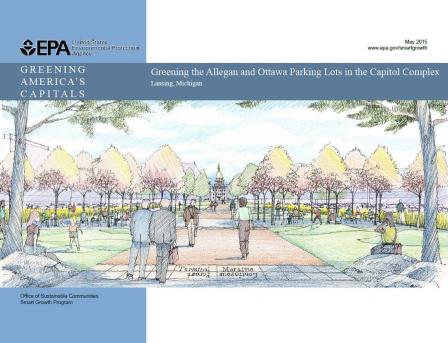Greening the Allegan and Ottawa Parking Lots in the Capitol Complex, Lansing, Michigan
A 10-acre parking lot currently breaks up the continuity and grandeur of Michigan’s capitol complex while creating a large area of impervious surface that contributes to water quality problems in the Grand River. The city of Lansing hoped to build consensus around a vision for the site that incorporates green infrastructure to reduce flooding and water pollution; improves walkability and transportation options; and spurs investment in nearby vacant and neglected property.
In 2013, the city applied to EPA’s Greening America’s Capitals Program to help realize this concept. EPA assembled a design team of federal agency staff and consultants to help the city and state create a vision for the site.

This report provides a comprehensive vision for the project site based on site analysis and community input gathered during a workshop in Lansing to develop shared goals and explore design options. The report illustrates potential improvements that could help realize the shared vision developed at the workshop and offers steps the city and state could consider taking to implement design changes.
The design options include:
- Using green infrastructure to capture and manage rainwater where it falls, improving water quality and reducing flooding while offering other environmental, economic, and social benefits.
- Designing streets so that people walking, biking, driving, or using public transportation can get around safely and efficiently.
- Using native plantings and landscapes to provide habitat and create natural areas for people to enjoy in the city.
Together, these design solutions could create a public space that improves the environment and public health and helps revitalize the surrounding area. As envisioned, the Michigan State Capitol Complex could become a model of environmental sustainability for the city and other communities throughout the state.
You will need Adobe Reader to view some of the files on this page. See EPA’s About PDF page to learn more.- Greening America's Capitals: Lansing, MI (PDF)(46 pp, 4 MB, 2015)
